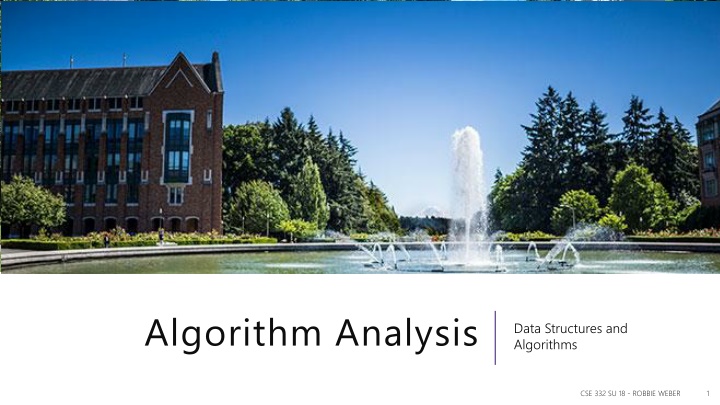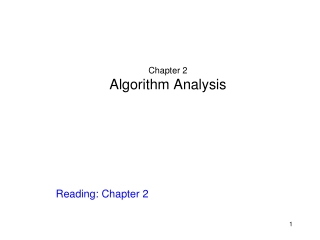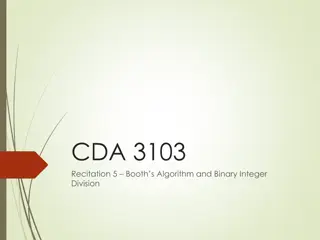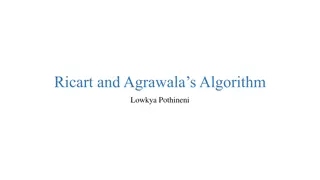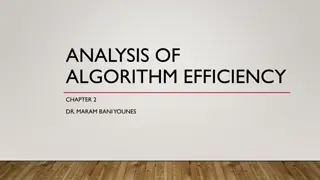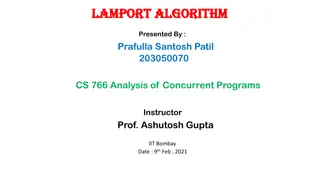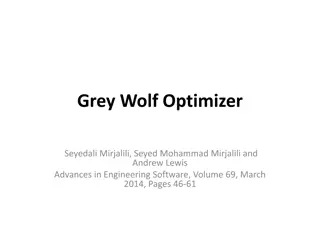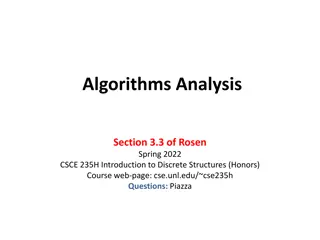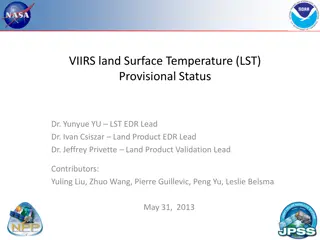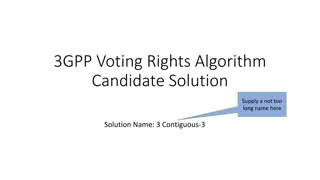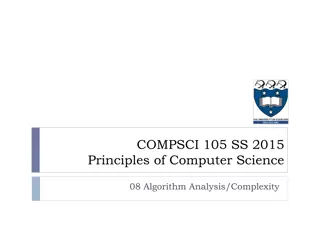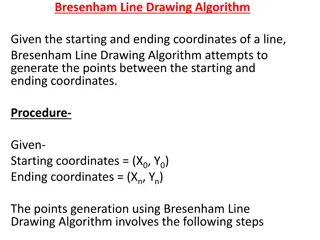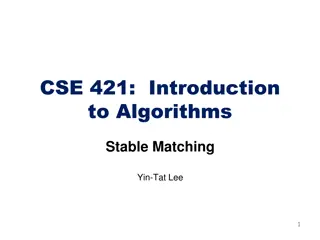Algorithm Analysis
We delve into algorithm analysis, comparing different approaches without executing code, and counting steps in various scenarios. Understanding theoretical concepts to optimize code efficiency and performance.
Download Presentation

Please find below an Image/Link to download the presentation.
The content on the website is provided AS IS for your information and personal use only. It may not be sold, licensed, or shared on other websites without obtaining consent from the author.If you encounter any issues during the download, it is possible that the publisher has removed the file from their server.
You are allowed to download the files provided on this website for personal or commercial use, subject to the condition that they are used lawfully. All files are the property of their respective owners.
The content on the website is provided AS IS for your information and personal use only. It may not be sold, licensed, or shared on other websites without obtaining consent from the author.
E N D
Presentation Transcript
Algorithm Analysis Data Structures and Algorithms CSE 332 SU 18 - ROBBIE WEBER 1
Logistics Piazza -Sign up for Piazza -Directions to opt out of Piazza careers are on piazza. Section tomorrow -Caitlin and Alon will co-lead section -Chance to practice problems about what we learned in lecture. -Occasionally learn new material -This week: Talk about concepts in your first programming project. Project 1 out (late) tonight If you don t have a partner yet, meet up here at the end of class, and we ll pair you up. CSE 332 SU 18 - ROBBIE WEBER 2
Algorithm Analysis I have some problem I need solved. Caitlin and Alon have different ideas for how to solve the problem. How do we know which is better? Easy. Have them both write the code and run it, and see which is faster. THIS IS A TERRIBLE IDEA THIS IS A TERRIBLE IDEA How can we analyze their suggestions before they have to write the code, and in a way that is independent of their machines? CSE 332 SU 18 - ROBBIE WEBER 3
Comparing Algorithms We want to know when one algorithm will be better than another -Better might mean faster. -Or using less memory. We really care about large inputs. -If n=15, any algorithm will probably finish in less than a second anyway Want our answer to be independent of computer speed or programming language. And we want an answer that s mathematically rigorous. CSE 332 SU 18 - ROBBIE WEBER 4
Analyzing Code Assume basic operations take the same constant amount of time. What s a basic operation? -Adding ints or doubles -Assignment -Incrementing a variable -A return statement -Accessing an array index or an object field What s not a basic operation? -Making a method call. This is a LIE but it s a very useful lie. CSE 332 SU 18 - ROBBIE WEBER 5
What Are We Counting? Worst case analysis -For a given input size, what s the running time for the worst state our data structure we can be in or the worst input we can give? Best case analysis -What is the number of steps for the best state of our structure and the best question? Average case analysis -How are we doing on average over all possible inputs/states of our data structure? -Have to ask this question very carefully to get a meaningful answer We usually do worst case analysis. CSE 332 SU 18 - ROBBIE WEBER 6
Example What is the worst case number of simple operations for this piece of code? Let A have ? entries. Linear search int linearSearch(int[] A, int target){ for(int i = 0; i < A.length; i++){ if(A[i] == target) return i; } return -1; } CSE 332 SU 18 - ROBBIE WEBER 7
Asymptotic Notation That s a nice formula. But does everything in it matter? Multiplying by constant factors doesn t matter let s just ignore them. Lower order terms don t matter delete them. Gives us a simplified big-O ?(?log?) ? ?3 ?(?log?) ?(8?) 10?log? + 3? 5?2log? + 13?3 20?loglog? + 2 ?log? 23? CSE 332 SU 18 - ROBBIE WEBER 8
Formally Big-O We wanted to find an upper bound on our algorithm s running time, but -We don t want to care about constant factors. -We only care about what happens as ? gets large. The formal, mathematical definition is Big-O. Big Big- -O O ?(?) is ?(? ? ) if there exist positive constants ?,?0 such that for all ? ?0, ? ? ? ? ? We also say that ? ? dominates ?(?). CSE 332 SU 18 - ROBBIE WEBER 9
Why is that the definition? Big Big- -O O ?(?) is ?(? ? ) if there exist positive constants ?,?0 such that for all ? ?0, ? ? ? ? ? Why ?0? Why ?? CSE 332 SU 18 - ROBBIE WEBER 10
Why Are We Doing This? You already intuitively understand what big-O means. Who needs a formal definition anyway? -We will. Your intuitive definition and my intuitive definition might be different. We re going to be making more subtle big-O statements in this class. -We need a mathematical definition to be sure we re on the same page. Once we have a mathematical definition, we can go back to intuitive thinking. -But when a weird edge case, or subtle statement appears, we can figure out what s correct. CSE 332 SU 18 - ROBBIE WEBER 11
Writing Proofs Claim: For every odd integer ?, there exists an even integer ?, such that ? > ?. Proof: Let ? be an arbitrary odd integer. By definition, ? = 2? + 1 for some integer ?. Consider x = 2(? + 1). ? is even (since it can be written as 2 times some integer) and ? = 2 ? + 1 = 2? + 2 > 2? + 1 = ?. CSE 332 SU 18 - ROBBIE WEBER 12
Writing Proofs Where did that ? = 2 ? + 1 come from? You probably came up with that even integer first, before you started writing the proof. That was some scratch work the insight isn t explained in the final proof -You just say Consider For this class, when you re writing big-O proofs, include both your scratch work and the final proof. -If you make a mistake, it s much easier for us to diagnose. -Which makes it easier for you to get partial credit. CSE 332 SU 18 - ROBBIE WEBER 13
Using the Definition Let s show: 10?2+ 15? is ?(?2) Recreation of whiteboard: Scratch work: 10?2 10?2 15? 15?2 for ? 1 10?2+ 15? 25?2for ? 1 Proof: Take ? = 25 and ?0= 1. The inequality 10?2 10?2 is always true. The inequality 15? 15?2 is true for ? 1, as the right hand side is a factor of ? more than the right hand side. As long as both inequalities are true we can add them, thus 10?2+ 15? 25?2 holds as long as ? 1. This is exactly the inequality we needed to show. CSE 332 SU 18 - ROBBIE WEBER 14
Edge Cases True or False: 10?2+ 15? is ?(?3) [this is an edge case] It s true it fits the definition. Big-O is just an upper bound. It doesn t have to be a good upper bound. If we want the best upper bound, we ll ask you for a tight ? ?2 is the tight bound for this example. It is (almost always) technically correct to say your code runs in time ?(?!). - DO NOT TRY TO PULL THIS TRICK ON AN EXAM. Or in an interview. tight big-O bound. CSE 332 SU 18 - ROBBIE WEBER 15
O, Omega, Theta [oh my?] Big-O is an upper bound upper bound - My code takes at most this long to run Big-Omega is a lower bound Big Big- -Omega Omega ?(?) is (? ? ) if there exist positive constants ?,?0 such that for all ? ?0, ? ? ? ? ? Big Theta is equal to Big Big- -Theta Theta ?(?) is (? ? ) if ? ? is ?(? ? ) and ? ? is (? ? ). CSE 332 SU 18 - ROBBIE WEBER 16
Viewing O as a class Sometimes you ll see big-O defined as a family or set of functions. O(? ? ) is the set of all functions ? ? such that there exist positive constants ?,?0 such that for all ? ?0, ? ? ? ? ? Big Big- -O (alternative definition) O (alternative definition) For that reason, some people write ? ? ? ? ?where we wrote ? ? is ?(? ? ) . Other people write ? ? = ? ? ? to mean the same thing. The set of all functions that run in linear time (i.e. ?(?)) is a complexity class. We ll talk more about complexity classes much later in the quarter. We never write ?(5?) instead of ?(?) they re the same thing! It s like writing 6 2 instead of 3. It just looks weird. CSE 332 SU 18 - ROBBIE WEBER 17
Useful Vocab The most common running times all have fancy names: ?(1) constant ?(log?) logarithmic ? ? linear ? ?2 quadratic ?(?3) cubic ?(??) polynomial (where c is a constant) ?(??) exponential (where c is a constant) CSE 332 SU 18 - ROBBIE WEBER 18
Whats the base of the log? If I write log?, without specifying a base, I mean log2?. But does it matter for big-O? Suppose we found an algorithm with running time log5? instead. Is that different from ? log2? ? No! log2? log2? If ? is a constant, then log2? is just a constant, and we can log?? = hide it inside the ?(). CSE 332 SU 18 - ROBBIE WEBER 19
